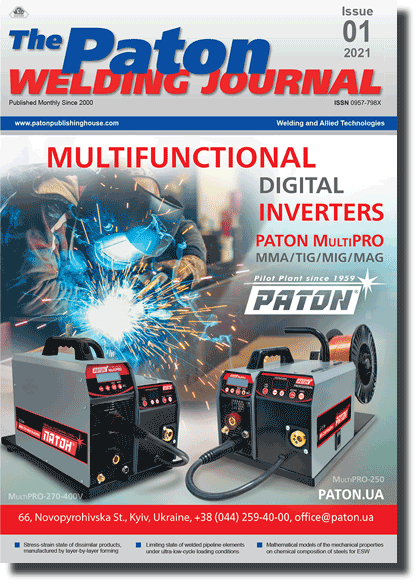| 2021 №01 (03) |
DOI of Article 10.37434/tpwj2021.01.04 |
2021 №01 (05) |

The Paton Welding Journal, 2021, #1, 18-22 pages
Comparative analysis of the results of computer simulation of heat transfer and hydrodynamic processes in the metal being welded by means of different software tools
O.P. Semenov1, I.V. Krivtsun1, A.V. Lykhoshva1, O.I. Hluchenkyi2 and O.I. Bondar2
1E.O. Paton Electric Welding Institute of NAS of Ukraine, 11 Kazymyr Malevych Str., 03150, Kyiv, Ukraine. E-mail: office@paton.kiev.ua
2The Institute of Electrodynamics of NAS of Ukraine 56 Peremohy Prosp. 03057, Kyiv, Ukraine
Abstract
In this work we considered two software tools for the purpose of multiphysics simulation of physical phenomena in weld pool: COMSOL Multiphysics and in-hose finite element (FE) code implemented in Wolfram Mathematica. For validation purpose, two test problems dealing with Marangoni induced convection are solved. Good agreement between benchmark solutions and obtained results is observed. Developed numerical algorithms and computer code can readily be employed for multiphysics simulation in welding. 14 Ref., 1 Table, 8 Figures.
Keywords: marangoni convection, weld pool shape, mathematical modelling, laser beam welding
Received 10.12.2020
References
1. Kou, S. (2002) Welding metallurgy. New Jersey, John Wiley & Sons. https://doi.org/10.1002/04714340272. Messler, Jr., Robert, W. (2008) Principles of welding: Processes, physics, chemistry, and metallurgy. New Jersey, John Wiley & Sons.
3. Limmaneevichitr, C., Kou, S. (2000) Visualization of Marangoni convection in simulated weld pools. Welding J., 79(5), 126-135.
4. Tsai, M. C., Kou, S. (1989) Marangoni convection in weld pools with a free surface. Int. J. for Numerical Methods in Fluids, 9(12), 1503-1516. https://doi.org/10.1002/fld.1650091206
5. Sahoo, P., Debroy, T., McNallan, M. J. (1988) Surface tension of binary metal-surface active solute systems under conditions relevant to welding metallurgy. Metallurgical Transact., B, 19(3), 483-491. https://doi.org/10.1007/BF02657748
6. Heiple, C.R. (1982) Mechanism for minor element effect on GTA fusion zone geometry. Welding J., 61(4), 97-102.
7. Pitscheneder, W. et al. (1996) Role of sulfur and processing variables on the temporal evolution of weld pool geometry during multikilowatt laser beam welding of steels. Ibid., 75(3), 71-80.
8. Kou, S., Sun, D.K. (1985) Fluid flow and weld penetration in stationary arc welds. Metallurgical Transact., A, 16(1), 203-213. https://doi.org/10.1007/BF02816047
9. Demchenko, V. F., Krivtsun, I. V., Krikent, I. V., Shuba, I. V. (2017). Force interaction of arc current with self-magnetic field. The Paton Welding J., 3, 15-24. https://doi.org/10.15407/tpwj2017.03.03
10. Brent, A.D., Vaughan R. Voller, K.T.J. Reid. (1988) Enthalpyporosity technique for modeling convection-diffusion phase change: Application to the melting of a pure metal. Numerical Heat Transfer, Pt A: Applications, 13(3), 297-318. https://doi.org/10.1080/10407788808913615
11. Zienkiewicz, O.C., Taylor, R.L. (2000) The finite element method. Vol. 3: Fluid dynamics. Oxford, Butterworth-Heinemann.
12. Gupalo, Yu P., Ryazantsev, Yu S. (1988) Thermocapillary motion of a liquid with a free surface with nonlinear dependence of the surface tension on the temperature. Fluid Dynamics, 23(5), 752-757. https://doi.org/10.1007/BF02614155
13. Saldi, Z. (2012) Marangoni driven free surface flows in liquid weld pools. Ph.D. Thesis, Delft University of Technology.
14. Cagnone, Jean Sébastien, Koen Hillewaert, Nicolas Poletz. (2014) A discontinuous Galerkin method for multiphysics welding simulations. Key Engineering Materials. 611. Trans. Tech. Publications Ltd. https://doi.org/10.4028/www.scientific.net/KEM.611-612.1319
Suggested Citation
O.P. Semenov, I.V. Krivtsun, A.V. Lykhoshva, O.I. Hluchenkyi and O.I. Bondar (2021) Comparative analysis of the results of computer simulation of heat transfer and hydrodynamic processes in the metal being welded by means of different software tools. The Paton Welding J., 01, 18-22.The cost of subscription/purchase order journals or individual articles
| Journal/Currency | Annual Set | 1 issue printed |
1 issue |
one article |
| TPWJ/USD | 384 $ | 32 $ | 26 $ | 13 $ |
| TPWJ/EUR | 348 € | 29 € | 24 € | 12 € |
| TPWJ/UAH | 7200 UAH | 600 UAH | 600 UAH | 280 UAH |
| AS/UAH | 1800 UAH | 300 UAH | 300 UAH | 150 UAH |
| AS/USD | 192 $ | 32 $ | 26 $ | 13 $ |
| AS/EUR | 180 € | 30 € | 25 € | 12 € |
| SEM/UAH | 1200 UAH | 300 UAH | 300 UAH | 150 UAH |
| SEM/USD | 128 $ | 32 $ | 26 $ | 13 $ |
| SEM/EUR | 120 € | 30 € | 25 € | 12 € |
| TDNK/UAH | 1200 UAH | 300 UAH | 300 UAH | 150 UAH |
| TDNK/USD | 128 $ | 32 $ | 26 $ | 13 $ |
| TDNK/EUR | 120 € | 30 € | 25 € | 15 € |
AS = «Automatic Welding» - 6 issues per year;
TPWJ = «PATON WELDING JOURNAL» - 12 issues per year;
SEM = «Electrometallurgy Today» - 4 issues per year;
TDNK = «Technical Diagnostics and Non-Destructive Testing» - 4 issues per year.


